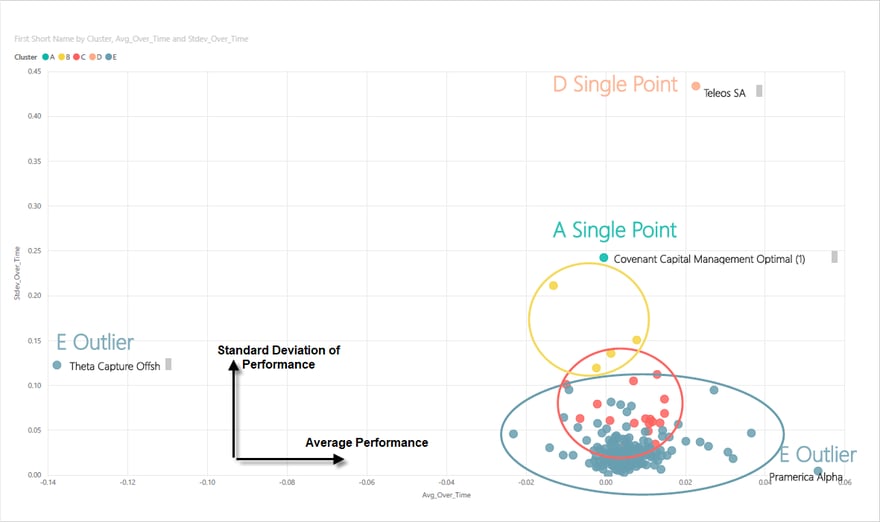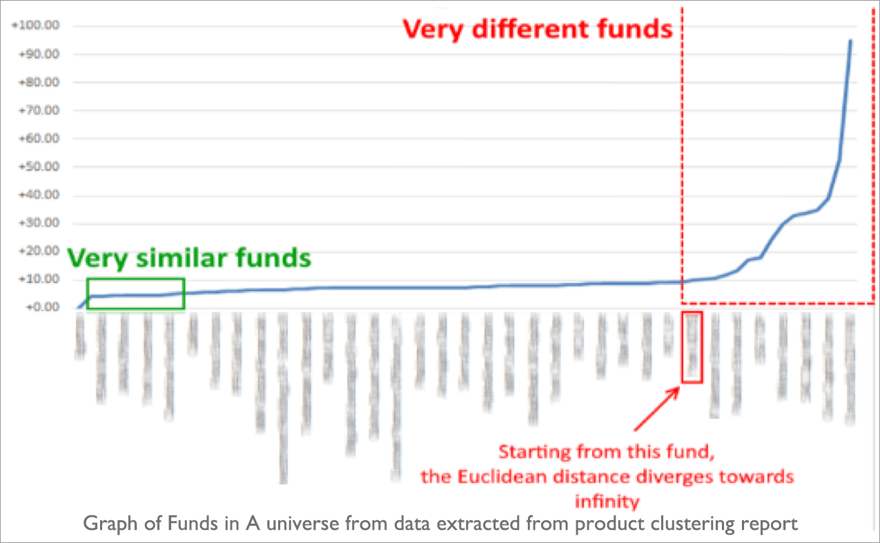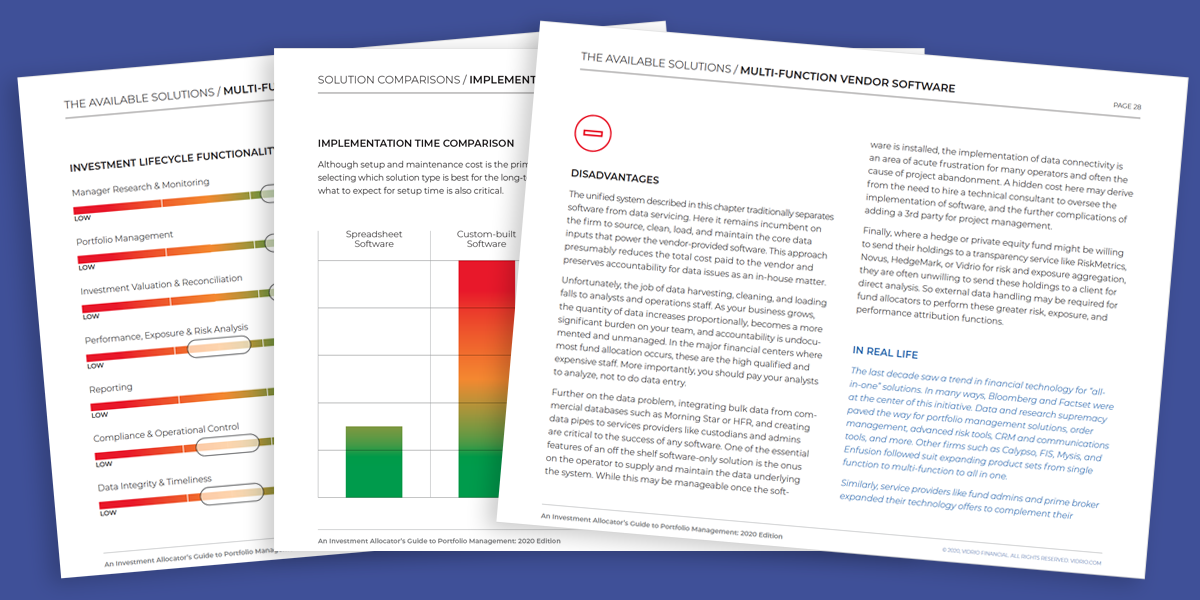The application of advanced algorithms and machine learning to the data collection and analytic services we offer is the one of the latest innovations to help clients solve complex allocation needs and build more efficient portfolios.
THE PROBLEM
As with all analytics, data is critical. But the sheer abundance of data makes it near impossible for any individual to spot trends and alignments that lie between funds and portfolios. Vidrio is offering new services to solve this problem for our clients with algorithmic intelligence to help allocators better assess their fund investments and portfolio allocations.
To help our allocator clients analyze and see hidden trends in their programs, Vidrio has introduced Algorithmic and Machine Learning based “Advanced Analytics.” These analytic tools compare underlying attributes of performance, risk, and exposure of portfolios and funds. The goal is to illustrate cases where funds with nominally different investment strategies are potentially similar. The benefits to clients are multifold, but include:
- Looking at portfolio diversification more deeply and with new perspectives
- Monitoring for instances of style drift among managers
- Assessing similarities among funds beyond simple performance correlation
NEW INNOVATIVE SOLUTIONS
1. "PRODUCT CLUSTERING"
“Product Clustering” is grouping a set of objects that are statistically similar given multi-dimensional correlations of their chosen attribute parameters. In this case, funds that have overlapping profiles across selected exposure, risk, and performance metrics.

Vidrio developed a custom approach that allows users to select analytic attributes and reveal which funds within a portfolio exhibit similarity with regards to these attributes.
For example, looking at a portfolio with long equity, credit arbitrage, and multi-strategy funds, a portfolio manager might find that five funds from these seemingly diversifying strategies are similar in-country exposure, standard deviation profiles, and certain risk factor sensitivities. The allocator could then monitor the fund to see if this was a spurious correlation, or a persistent issue in the portfolio composition.
In this framework, Vidrio clients can select which attributes to test for and view results across both actual and simulated portfolio constructions.
2. "PRODUCT SIMILARITY"
Product Similarity is an advanced analytics feature that identifies likenesses or dissimilarities between individual products (funds and/or portfolios) across multiple variables or dimensions (inputs) through the calculation of the Euclidean distance measure and the Pearson’s correlation coefficient.

In layman’s terms, we are looking for instances where computed statistics are similar between funds. Vidrio’s systems use newly introduced algorithms to look for these similarities across a field of data that is more than a human could probably assess.
“Product Similarity” and “Product Clustering” mostly use the same core functions. The difference is that while “Clusters” is looking to clump a group of managers together as a pack, “Similarity” is comparing one fund or portfolio against another to assess likeness.
3. STYLE AND STRATEGY AUTO CLASSIFICATION
Taking product clustering and similarity features one step further, Vidrio employs Machine Learning to suggest alternate classifications for managers based on their derived profiles.
For example, a manager who may self-describe as “long/short credit” may profile consistently in line with Global Macro in Vidrio’s assessment. However, it is not a purely “Vidrio” assessment - Vidrio trains the algorithm according to each client’s database to establish a strategy, sub-strategy, and style profiles based on multiple categorical exposure data fields. This is because clients often use their own strategy classifications.
Vidrio can further delineate managers into sub-strategies. In the example above, the newly categorized global macro manager might further be classified into an emerging market macro or developed market global macro sub-strategy type depending on their aggregated profile.
Vidrio can set guidelines to continuously monitor and compare ML classifications to manually input classifications for all entities – flagging deviations that occur for more than three months, as an early detection mechanism for identifying strategy or style drift.
WHY IT MATTERS
“Manager of Manager” institutional investors often have an extra degree of variability and a lesser degree of control than a direct investment strategy. Allocators cannot dictate an underlying fund’s decision making (nor do they want to), and the breadth of underlying securities, strategies, and managers in a co-mingled alternatives portfolio creates a wider array of possible outcomes.
For these reasons and more, allocators are critically dependent on their specific assessment of a fund’s profile and their fund partners to be consistent in their stated investment style and objectives. A fund that moves away from investment expectations creates an additional layer of variability for the allocator and can upset the portfolio’s structure and risk profile.
With Product Clustering, Product Similarity, and Auto Classification, Vidrio is looking to help our clients monitor and assess these variations to optimize portfolio construction. This is a function that allocators previously performed mainly using manager returns profiles and exposure profiles. Vidrio is taking this function into the future by applying advanced computing power to look at more dimensions of portfolio attributes and giving allocators more in-depth insight into their portfolio composition.
These features allow allocators to make better-informed decisions in allocating and structuring their portfolios. The availability of deep computational and comparative approaches, on top of program-wide data, allows allocators to consider how to best diversify their portfolio. It also reveals instances where diversification that was previously assumed may not be true when multiple lenses are applied to the data.
Vidrio is continuously striving to provide our clients with the best tools available to make the most informed decisions leveraging the innovations available with the power of big data, machine learning, and human innovation.
Request a consultation to learn more about these features.
Originally published via Alternatives Watch.







